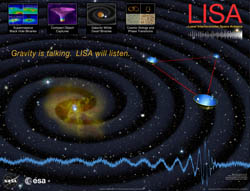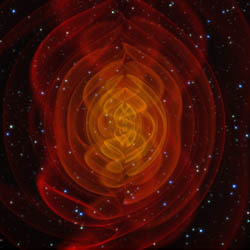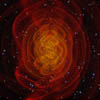Profile: Dr. John Baker
Understanding the extreme gravity in the merger of black holes -- as predicted by Einstein -- is what drives John's research. These mergers may be the most energetic of all astronomical events, briefly releasing energy at a rate 100 billion trillion times that of the Sun.
Biography
As long as he can remember, John has been interested in the nature of the world, a result of his natural appreciation and respect for it. Growing up, he was fascinated by how much he could learn with just careful observation and thought. Astronomy was particularly attractive, because the vast majority of the natural world is not on the Earth. Lying on the ground looking up into the sky, John remembers feeling like a speck on a small ball moving through immense space.
Physics held a particular fascination because it describes so many different phenomena in relatively few simple rules. He was drawn to the most fundamental aspects of physics, especially gravitational physics. While the subject is well-described by Einstein's theory of general relativity, 100 years later it remains mysterious. John was led back to astronomy because of the grand scale of gravitational physics in the Universe.
John grew up in the suburbs of Kansas City, Missouri, earning a B.S. in Physics with a minor in Philosophy from Northeast Missouri State University, now Truman State University. His PhD from Penn State is in - no surprise - gravitational physics. John's thesis work focused on understanding the consequences of Einstein's landmark theory of gravity. The theory provides specific predictions for strong gravitational physics in the merger of two black holes into one, and John's thesis addressed the dynamics of a distorted black hole formed by the merger of two black holes.
Post-PhD
For three years, John was a postdoc at the Albert-Einstein-Institut Potsdam, Germany. He was part of a large group attempting to develop techniques to solve Einstein's equations on supercomputers, the only way to understand the predicted behavior of those merging black holes. The center of his work there was the "Lazarus Project."
Einstein's theory has been verified in many ways, such as with studies of the motion of solar system objects and by measuring the effect of gravity in bending light as it passes the Sun or other large astrophysical objects. One spectacular prediction of this theory is that dense binaries, such as compact neutron stars circling around each other, will lose energy by emitting gravitational waves, ripples in the fabric of spacetime that carry energy from the system out through space. Russell Hulse and Joseph Taylor received a Nobel Prize in 1993 for radio observations of such a system that were consistent with Einstein's predictions.

Click for larger image
Depiction of gravitational waves emitted from the massive black-hole binary at the center of a galaxy; the blue waveform at the bottom is the type of signal that LISA will detect from such an event, and the four boxes at the top represent the four main classes of LISA sources.
The main goal of John's work was always rooted in the possibility of testing Einstein's theory against actual gravitational wave observations. Several efforts are now underway to make the first direct observation of gravitational waves with ground-based detectors. While these instruments may be sensitive to mergers of star-sized black holes in nearby galaxies, they are not likely to measure signals from the biggest black holes at the centers of galaxies. NASA, in collaboration with the European Space Agency, is building a space-based instrument, the Laser Interferometer Space Antenna (LISA). The mission's goal is to observe mergers of these supermassive black holes, with perhaps millions of times the mass of the Sun, over vast distances in the Universe.
Getting the most from LISA's observations requires a full understanding of the predicted gravitational signals from the mergers. John's background in computational modeling (numerical simulations) therefore made him an excellent choice for hire as a LISA postdoc. He came to the NASA Goddard Space Flight Center in 2001 and was later hired permanently as a civil servant.
Current Work
John is now settled in as an astrophysicist in Goddard's Gravitational Astrophysics Laboratory. Since his arrival, the group's work -- along with revolutionary advances in the field of numerical relativity -- now allows them to routinely calculate the interactions of merging black holes to help them understand exactly how they emit their gravitational waves.

Click for larger image
Computer simulation of black holes distorting space-time (yellow lines) and emitting gravitational waves as they spiral towards each other (Image: Henze/NASA)
The details of these interactions are dependent on the binary's orbits and black holes themselves. Each black hole can be characterized by its mass and its angular momentum ("spin"), which influence its behavior in an interaction. For instance, when the black hole spins are aligned with the orbital axis, this can delay or accelerate the final moments of the merger. When the spins and orbit are not aligned, these interactions lead to precession, somewhat like the precession in the Earth-Moon system, but far stronger.
John's research group is working toward a more complete understanding of how well LISA will be able to measure the parameters of these systems. These include the masses of each black hole, the magnitudes and orientations of their spins, the orientation of the binary system, and the location of the merger in space and time.
They expect LISA to make detailed measurements about black holes merging far, far away -- so distant that, even though gravitational waves are believed to travel at the speed of light, the signals would have taken most of the age of the Universe to arrive at our solar system. Most of the mergers LISA will observe are expected to have occurred when the Universe was less than half its current age, or perhaps ten times younger. These observations can tell us about the early Universe when galaxies were forming, merging, and growing.
Read about some of John's work and his receipt of the Lindsay Award in 2008 and a New Scientist article on his work from 2006.
Typical Day
In the Gravitational Astrophysics Lab, John works with a team of scientists, postdocs, and students on large computer calculations to simulate merging black holes. Their aim is to characterize and quantify the results and study how LISA will measure these systems. As part of this work, John runs simulations and writes (and debugs) computer programs to conduct new studies. He discusses these activities with the team to solve problems and keep the research moving forward. John also writes up the results of their research for scientific journals and gives presentations at conferences and research institutes around the world.
He also contributes to other research groups, such as the Mock LISA Data Challenge. This international effort generates simulated LISA data and challenges other research groups to identify their gravitational wave sources. These Challenges and other projects usually involve a couple of telecons each week.
What's Best About Working in Science?
Like other researchers, John finds adventure in investigating new scientific questions and learning more about the Universe and how it operates. He also enjoys working with his fellow scientists and with fascinating people from all over the world.
Other Interests
Spending time with his family is John's favorite thing to do. He has two children, in elementary and middle school, and he loves teaching them new things and spending time together at home and outdoors. His family attends a Quaker Meeting, sharing the values of equality, simplicity, integrity, search for truth, and pacifism. John and his family are vegetarians, and he makes time to cook for everyone on the weekends.
With interests of all kinds, John is also the captain of a soccer team, and he likes to learn new languages. He also claims to enjoy the occasional home-remodeling project; we'll take his word for that.
Questions and Answers
If time travel were possible, when and where would you visit, and why?
If time travel were possible, that in itself would probably be the most interesting scientific and technological development that had ever happened. I am sure I would want to travel to meet the scientists who understood that technology and learn from them what deep insights they had about how the Universe works.
If you weren't a scientist, what would you be?
Wow, that's a tough one! I think most people become scientists because that is what they really want to do. Science is a creative endeavor which requires a lot of dedication, taking a long time to build a career. People who follow that career path do so because they love discovery and the process of using their technical skills to figure out new truths about the world to share with others. In some ways, this may be similar to fine arts. Perhaps if I wasn't a scientist, I would hope to have the skills to be a fine artist.
Who was your favorite teacher in school? What was this teacher like and how did he/she influence your life?
I didn't really have a favorite, but I learned a lot from interacting with my teachers outside of class and getting their help to pursue the things I found interesting, beyond what was discussed in class.
What do you think is the most important technological advance that has occurred in your lifetime?
Without a doubt, it is the internet and its associated technologies and resources. When I was young and interested in science, it was really very difficult to find any information about science beyond what was in an encyclopedia. I learned a lot from reading the encyclopedia as a kid. Now it is almost trivially easy to find information. The trade-off, of course, is that, unlike an encyclopedia, there is little editing or quality control of the information on the internet. Each person is responsible to think critically about what they read. I would guess we are still at the beginning of the revolution that this will create in the way we learn, process, and know information about the world.
Publication Date: January, 2010




